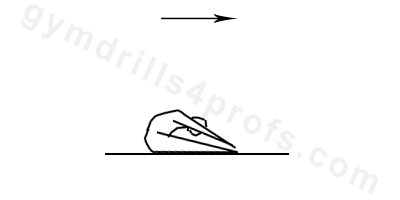


The shoulderstand is very similar to a press handstand. The main difference is that the end of the skill, the body is positioned in vertical with arms bent. To perform this skill, the gymnast should start in support or L-sit and raise their buttocks slowly. They should compress their body into a piked position. When the upper body reaches vertical, the gymnast should lift their legs to the vertical position as well. At the same time, the gymnast should slowly bend their arms until they reach the shoulder stand position. Their head should be slightly open and the gymnast should watch the floor. The gymnast should not touch the cables with any part of their body or upper arms. They should hold this skill in a straight, slightly hollow position.

The support position is a basic skill on rings. The body should be straight, arms tight, with wrists twisted forwards. The rings should be turned out so that if a person were to stand in front of the gymnast, they would be able to see their wrists. The ring cables should not touch the body or arms. The gymnast’s head should be in a neutral position with their chin slightly up.

The starting position is support on the parallel bars. The gymnast should hold a straight body and bend their arms as much as they possibly can. More than 90° is preferred. Finish the skill by straightening the arms and returning to the support position. The gymnast should avoid arching and kicking with their legs.

To perform a press to handstand on floor, the gymnast should start this skill with their legs open around shoulder width, or slightly further. The gymnast should put their hands on the floor at shoulder width. The distance between the hands and feet shouldn’t be too far. If the gymnast is to go on their tippy toes, their upper body should be at vertical (excluding shoulder angle). Next, the gymnast should raise their buttocks while only touching the floor with their hands. When the body and the arms are in a completely straight line, the legs should raise until the gymnast reaches handstand.

A handstand is a very important skill because it’s incorporated in a large number of gymnastics skills across every event, including pommel horse. The body in a handstand should be in a completely straight position. The gymnast’s arms should be tight and at shoulder width. Fingers on the floor should be spread in a frontal position, the head should be slightly open, with eyes watching the floor “in between the eyebrows”. The gymnast’s back should be completely straight, there should be no arch. The gymnast should squeeze their buttocks, keep their legs tight, and point their toes. Have the gymnast practice balancing in this position for increasingly longer periods of time.

The shoulderstand on parallel bars is similar to the shoulder stand on rings. The main difference between these skills is that performing it on the parallel bars is much easier, because the support on the hands is stable. Rings tend to move, while rails do not. From support or L-sit, the gymnast should slowly raise their buttocks, compressing their body in a piked position. When the upper body reaches vertical, the gymnast should lift their legs to vertical too. At the same time, the gymnast should slowly bend their arms until they reach the shoulder stand position. The head should be slightly open and the gymnast should watch the floor. The gymnast’s body should be straight, in a slightly hollow position.

The pike compression is very important to properly execute a press to handstand and shoulderstand. Gymnasts should practice their pike stretch to improve their flexibility. When the gymnast is flexible, they can compress their body much better and perform the skill much easier. There are a variety of drills that can be used to help improve a gymnast’s flexibility.
Integral part of gymnastics coaching process are skill drills. They help gymnasts to learn easier and technically correct. With GYM DRILL PRO you will find variety of ideas for the most the basic gymnastics skills. There are plenty of images with skill drill progressions. It is intended to support explicitly the qualified coaches in their daily coaching business. DO NOT practice without the guidance of proper professionals.